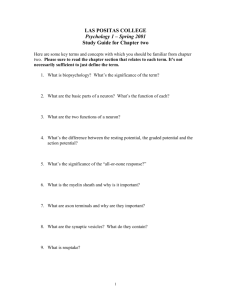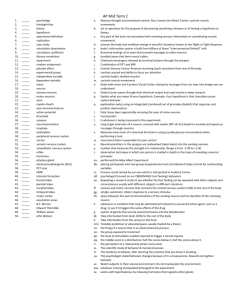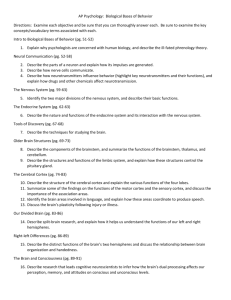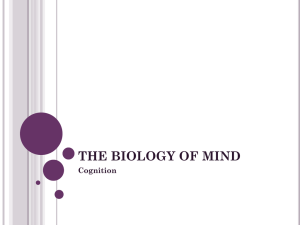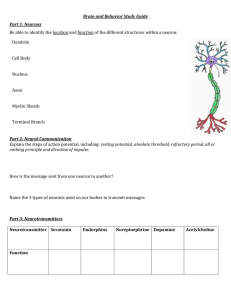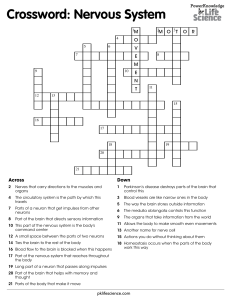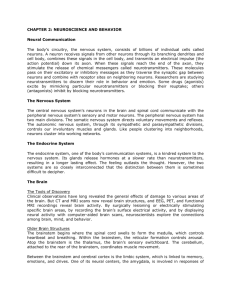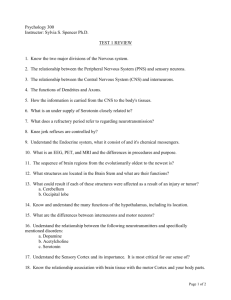File - Thrive in AP Psychology
advertisement
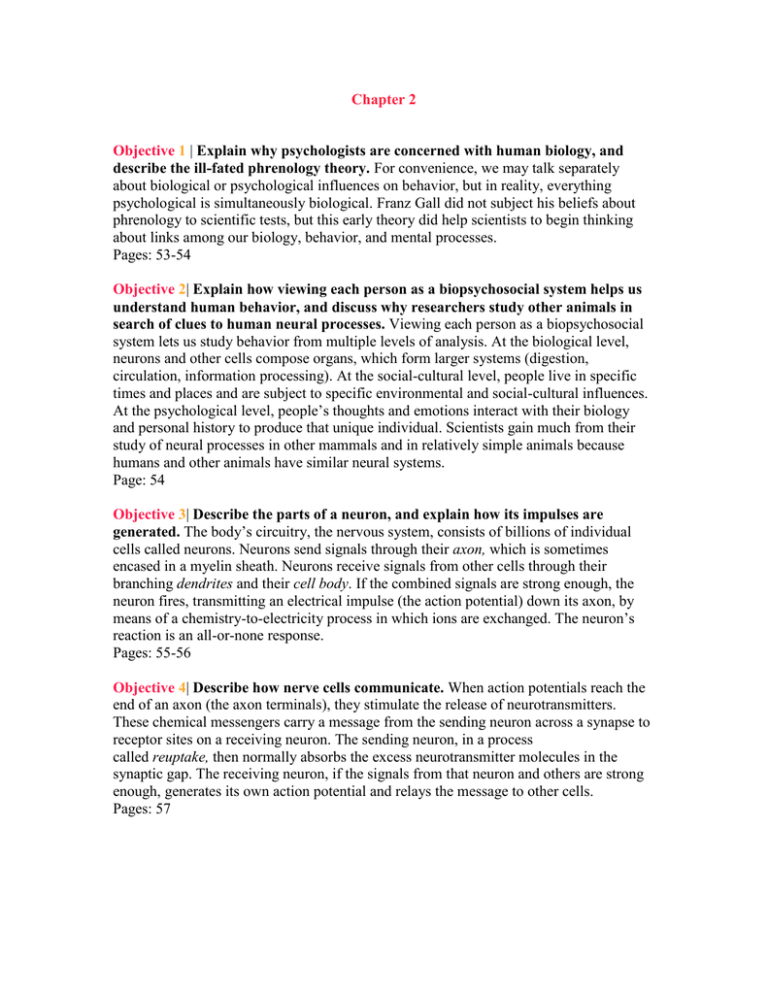
Chapter 2 Objective 1 | Explain why psychologists are concerned with human biology, and describe the ill-fated phrenology theory. For convenience, we may talk separately about biological or psychological influences on behavior, but in reality, everything psychological is simultaneously biological. Franz Gall did not subject his beliefs about phrenology to scientific tests, but this early theory did help scientists to begin thinking about links among our biology, behavior, and mental processes. Pages: 53-54 Objective 2| Explain how viewing each person as a biopsychosocial system helps us understand human behavior, and discuss why researchers study other animals in search of clues to human neural processes. Viewing each person as a biopsychosocial system lets us study behavior from multiple levels of analysis. At the biological level, neurons and other cells compose organs, which form larger systems (digestion, circulation, information processing). At the social-cultural level, people live in specific times and places and are subject to specific environmental and social-cultural influences. At the psychological level, people’s thoughts and emotions interact with their biology and personal history to produce that unique individual. Scientists gain much from their study of neural processes in other mammals and in relatively simple animals because humans and other animals have similar neural systems. Page: 54 Objective 3| Describe the parts of a neuron, and explain how its impulses are generated. The body’s circuitry, the nervous system, consists of billions of individual cells called neurons. Neurons send signals through their axon, which is sometimes encased in a myelin sheath. Neurons receive signals from other cells through their branching dendrites and their cell body. If the combined signals are strong enough, the neuron fires, transmitting an electrical impulse (the action potential) down its axon, by means of a chemistry-to-electricity process in which ions are exchanged. The neuron’s reaction is an all-or-none response. Pages: 55-56 Objective 4| Describe how nerve cells communicate. When action potentials reach the end of an axon (the axon terminals), they stimulate the release of neurotransmitters. These chemical messengers carry a message from the sending neuron across a synapse to receptor sites on a receiving neuron. The sending neuron, in a process called reuptake, then normally absorbs the excess neurotransmitter molecules in the synaptic gap. The receiving neuron, if the signals from that neuron and others are strong enough, generates its own action potential and relays the message to other cells. Pages: 57 Objective 5| Explain how neurotransmitters affect behavior, and outline the effects of acetylcholine and the endorphins. Each neurotransmitter travels a designated path in the brain and has a particular effect on behavior and emotions. Acetylcholine, one of the best-understood neurotransmitters, affects muscle action, learning, and memory. The endorphins are natural opiates released in response to pain and exercise. Pages: 58-59 Objective 6| Explain how drugs and other chemicals affect neurotransmission, and describe the contrasting effects of agonists and antagonists. Drugs and other chemicals affect communication at the synapse. Agonists, such as some of the opiates, excite by mimicking particular neurotransmitters or by blocking their reuptake. Antagonists, such as curare, inhibit a particular neurotransmitter’s release or block its effect. Pages: 59-60 Objective 7 | Describe the nervous system’s two major divisions, and identify the three types of neurons that transmit information through the system. One major division of the nervous system is thecentral nervous system (CNS), which consists of the brain and spinal cord. The other is the peripheral nervous system (PNS), which consists of the neurons that connect the CNS to the rest of the body by means of nerves (bundled axons of the sensory and motor neurons). Sensory neurons carry incoming information from sense receptors to the CNS, and motor neurons carry information from the CNS out to the muscles and glands. Interneurons communicate within the CNS and between sensory and motor neurons. Pages: 61-62 Objective 8| Identify the subdivisions of the peripheral nervous system, and describe their functions. The peripheral nervous system has two main divisions. The somatic nervous system enables voluntary control of the skeletal muscles. The autonomic nervous system, through its sympathetic and parasympathetic divisions, controls our involuntary muscles and glands. Pages: 62 Objective 9| Contrast the simplicity of the reflex pathways with the complexity of neural networks. Reflex pathways are automatic inborn responses to stimuli, and they do not rely on conscious decisions made in the brain. A single sensory neuron, excited by some stimulus (such as a flame), passes a message to an interneuron in the spinal cord. The interneuron activates a motor neuron, causing some muscle reaction (such as jerking away from the heat source). In contrast, neural networks, found in the brain, are clusters of many neurons that together share some special task. These complex networks strengthen with use, learning from experience. Each neural network connects with other networks performing different tasks. Pages: 63-65 Objective 10 | Describe the nature and functions of the endocrine system and its interaction with the nervous system. The endocrine system is a set of glands that secrete hormones into the bloodstream. These chemical messengers travel through the body and affect other tissues, including the brain. Some hormones are chemically identical to neurotransmitters. The endocrine system’s master gland, the pituitary, influences hormone release by other glands. In an intricate feedback system, the brain’s hypothalamus influences the pituitary gland, which influences other glands, which release hormones, which in turn influence the brain. Pages: 65-67 Objective 11 | Describe several techniques for studying the brain. Clinical observations have long revealed the general effects of damage to various areas of the brain. But MRI scans now reveal brain structures, and EEG, PET, and fMRI (functional MRI) recordings reveal brain activity. By surgically lesioning or electrically stimulating specific brain areas, by recording the brain’s surface electrical activity, and by displaying neural activity with computer-aided brain scans, neuroscientists explore the connections among brain, mind, and behavior. Pages: 68-70 Objective 12 | Describe the components of the brainstem, and summarize the functions of the brainstem, thalamus, and cerebellum. The brainstem is the oldest part of the brain and is responsible for automatic survival functions. Its components are the medulla (which controls heartbeat and breathing), the pons (which helps coordinate movements), and the reticular formation (which affects arousal). The thalamus, the brain’s sensory switchboard, sits above the brainstem. The cerebellum, attached to the rear of the brainstem, coordinates muscle movement and helps process sensory information. Pages: 70-72 Objective 13 | Describe the structures and functions of the limbic system, and explain how one of these structures controls the pituitary gland. Between the brainstem and cerebral cortex is the limbic system, which is linked to emotions, memory, and drives. One of its neural centers, the amygdala, is involved in responses of aggression and fear. Another, the hypothalamus, is involved in various bodily maintenance functions, pleasurable rewards, and the control of the hormonal system. The hypothalamus sits just above the pituitary (the “master gland”) and controls it by stimulating it to trigger the release of hormones. The hippocampus, also part of the limbic system, processes memory. Pages: 72-74 Objective 14| Define cerebral cortex, and explain its importance for the human brain. The cerebral cortex is the thin surface layer of interconnected neurons covering the brain’s hemispheres. The human brain’s cortex is larger than that of other animals, and it enables learning, thinking, and the other complex forms of information processing that make us uniquely human. Pages: 74 Objective 15 | Identify the four lobes of the cerebral cortex. Each cerebral hemisphere has four geographic areas. The frontal lobe, just behind the forehead, is involved in speaking, muscle movements, and planning and judgments. The parietal lobes, at the top of the head and toward the rear, receive sensory input for touch and body position. The occipital lobes, at the back of the head, include visual areas. The temporal lobes, just above the ears, include auditory areas. Each lobe performs many functions and interacts with other areas of the cortex. Pages: 75-76 Objective 16| Summarize some of the findings on the functions of the motor cortex and the sensory cortex, and discuss the importance of the association areas. Some areas of the brain serve specific functions (see Figure 2.23 on page 75). One such area is the motor cortex, an arch-shaped region at the rear of the frontal lobes that controls voluntary movements. Another is the sensory cortex, a region at the front of the parietal lobes that registers and processes body sensations. In these regions, body parts requiring precise control (in the motor cortex) or those that are especially sensitive (in the sensory cortex) occupy the greatest amount of space. Most of the brain’s cortex—the major portion of each of the four lobes—is devoted to uncommitted association areas, which integrate information involved in learning, remembering, thinking, and other higher-level functions. Pages: 77-80 Objective 17 | Describe the five brain areas that would be involved if you read this sentence aloud. Language results from the integration of many specific neural networks performing specialized subtasks. When you read aloud, your brain’s visual cortex registers words as visual stimuli, the angular gyrus transforms those visual representations into auditory codes, Wernicke’s area interprets those codes and sends the message to Broca’s area, which controls the motor cortex as it creates the pronounced words. Pages: 80-82 Objective 18| Discuss the brain’s plasticity following injury or illness. If one hemisphere is damaged early in life, the other will pick up many of its functions. This plasticity diminishes later in life, although nearby neurons may partially compensate for damaged ones after a stroke or other brain injury. Pages: 82-83 Objective 19| Describe split-brain research, and explain how it helps us understand the functions of our left and right hemispheres. Clinical observations long ago revealed that the left cerebral hemisphere is crucial for language. Split-brain research (experiments on people with a severed corpus callosum) has confirmed that in most people the left hemisphere is the more verbal, and that the right hemisphere excels in visual perception and the recognition of emotion. Studies of healthy people with intact brains confirm that each hemisphere makes unique contributions to the integrated functioning of the brain. Pages: 83-88 Objective 20| Discuss the relationships among brain organization, handedness, and mortality. About 10 percent of us are left-handed. Almost all righthanders process speech in the left hemisphere, as do more than half of all left-handers. The remainder of left-handers split about evenly in processing language in the right hemisphere or in both hemispheres. The percentage of lefties decreases sharply with age, from about 15 percent at age 10 to less than 1 percent at age 80. This decline may reflect a higher risk of accidents. Pages: 88-91
